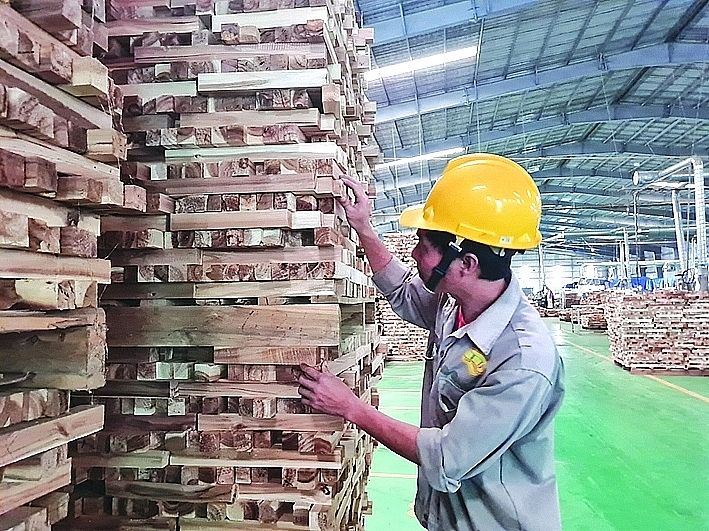 |
| Many timber enterprises are falling into a situation of high inventory, difficult to turn around capital. Photo: N.Thanh |
Over 50% off orders
Contacting and listening to the stories of many timber exporters in recent days, reporters noted sadness and gloom. Nguyen Hoang Ly, Director of Moc Quyet Thang Co., Ltd (in Quarter 8, Long Binh ward, Bien Hoa city, Dong Nai province) said the market of laminated timber has been stable for the past 10 years. Notably, during the Covid-19 pandemic, the market for laminated timber developed very well, there were times when goods could not be sold in time, and there was no inventory of raw materials in stock.
However, in the past 8 months, the consumption of wood for jointed bars has decreased significantly. Enterprise orders have decreased by more than 50% and exports are low.
The remaining orders that customers have placed before, partners also extend and delay delivery. The output of laminated wood is to make tables, chairs, cabinets, and beds for export to the US and EU. The economic downturn in these markets caused output “blocking” and no export orders.
“Enterprises fall into a difficult situation of capital turnover. In the context of high interest rates, businesses are facing difficulties in finance and orders as well as the market. Enterprises are currently trying to hold out from small production and export orders to maintain operations and retain workers,” said Ly.
At Hai Oanh Forest Products Import-Export and Production Co., Ltd (Yen Thai village, Te Loi commune, Nong Cong district, Thanh Hoa province), many stacks of wood joinery are also lying dormant.
This enterprise is under great pressure when it has about 1,400 m3 of plywood, equivalent to about 20 billion VND in capital.
Do Van Hai, Director of Hai Oanh Forest Products Import-Export Production Co., Ltd. said enterprises have two business segments, which are laminated wood and wood chips.
Enterprises entered the plywood market in 2018, when the market was in great demand.
An expensive market is when businesses are still confused. Entering 2020 and 2021, the market is still full of orders due to the increased demand for the production and processing of furniture and outdoor wood products. However, starting from the first quarter of 2022, businesses could no longer sell. Goods cannot be sold, but businesses still have to pay interest and many other expenses. The company had to cut 80% of its employees from the end of the first quarter of 2022.
Do Van Hai added we manufacture and sell to trading companies in Ho Chi Minh City and Binh Duong. Here, they have factories that produce deep processing of wardrobes and furniture for export to the US and EU markets. However, high inflation and economic recession in these countries make most people in markets that prioritize food and food consumption, tend to reduce spending on luxury goods. Furniture is considered a non-essential item, making it very difficult to consume. Because they can no longer export products, wood processing factories stop buying raw wood.
Hold on and wait for the market to “warm up”
In order to remove some of the difficulties, the wood joinery enterprises had to choose a plan to lower the price of their products. In the past, the price of laminated wood was about 12 million VND/m3 (in 2021), but now many businesses offer it in the market for only 8-9 million VND/m3. This is the price below the cost of production. However, even though they accept to sell at a loss to recover capital, businesses cannot sell their products. The essence of the story is not the price but the absence of an output market.
Do Van Hai said: “If the market for wood materials is ‘warm’, it will take 6-8 months for businesses to clear all inventories, then production activities will return to normal. However, if the ‘freezing’ situation of the furniture industry lasts, the risk is that the company will not be able to hold out. Currently, in Thanh Hoa, there are a number of factories specializing in the production of laminated timber that have fallen into bankruptcy and have to sell their factories.
In the current context, many timber enterprises have chosen to “hibernate” to wait for the market to “warm” gradually. When and how long this wait will be depends on the resources of each enterprise. “Most businesses are facing difficulties. The company is trying to keep operating at around 50%. The money comes in slowly, businesses maintain bank interest and workers’ wages,” added Nguyen Hoang Ly.
Normally, the production of laminated timber is twice as profitable as making wood chips. However, this year the situation is somewhat unusual when the wood chips are sluggish, while from the beginning of the year until now, wood chips have been very popular and well-priced.
When the reporter asked the question of whether or not the wood-joint enterprises have considered the plan to gradually convert their business products from wood-joint-bar to wood chips, many businesses expressed a rather troubled attitude.
Nguyen Hoang Ly confided: “The enterprise, which specializes in supplying raw wood, is also difficult to switch to a new direction”.
Besides, currently the woodchip industry is “hot”, but the woodchip enterprises are very concerned, will the woodchip industry develop as well in a few years as it is now? Enterprises changing business direction at the present time still have time to benefit from the “hot” woodchip market.
